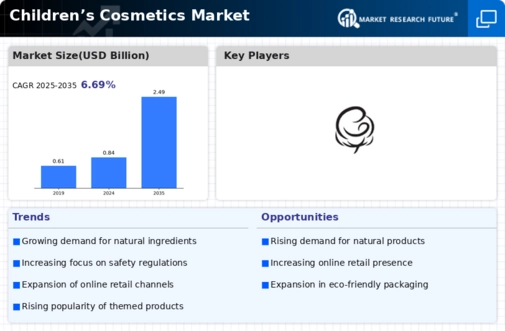Top Industry Leaders in the Children’s Cosmetics Market
 The competitive landscape of the Children's Cosmetics Market is dynamic, reflecting the increasing demand for safe and appealing cosmetic products targeted at young consumers. Several key players dominate this space, employing various strategies to gain market share and maintain a competitive edge.
The competitive landscape of the Children's Cosmetics Market is dynamic, reflecting the increasing demand for safe and appealing cosmetic products targeted at young consumers. Several key players dominate this space, employing various strategies to gain market share and maintain a competitive edge.
Key Players:
- Nestle S.A.
- BABISIL
- Cotton Babies Inc.
- Danone S.A.
- The Himalaya Drug Company
- Farlin Infant Products Corporation
- Mead Johnson Nutrition Company
- Townley Inc.
- L’ORÉAL S.A.
- Puttisu-USA
- Foshan Akia Cosmetics Co. Ltd.
Strategies Adopted:
**Product Innovation:** Key players consistently introduce new, innovative products, focusing on formulations that are gentle on children's skin while meeting parents' expectations for safety and quality.
**Marketing and Branding:** Companies invest heavily in marketing and branding strategies to establish trust with parents. Emphasizing the use of non-toxic ingredients and dermatologist-tested formulations is a common approach.
**Collaborations and Partnerships:** Strategic collaborations with popular children's characters and franchises have become prevalent. These partnerships help companies leverage established brand equity and appeal directly to their target audience.
**Global Expansion:** Many key players are expanding their market presence globally, capitalizing on the increasing awareness of safe cosmetics for children in emerging markets.
Market Share Analysis:
**Product Safety:** Given the sensitive nature of the target demographic, adherence to stringent safety standards is a critical factor influencing market share. Companies with a proven track record of safe products gain the trust of parents.
**Brand Recognition:** Established brands with a legacy in the overall cosmetics industry have an advantage due to brand recognition. Consumers often lean towards trusted names when choosing products for their children.
**Distribution Network:** A robust and extensive distribution network is essential for market penetration. Companies with strong partnerships and wide-reaching distribution channels can make their products more accessible to consumers.
**Innovation Capabilities:** The ability to continuously innovate and introduce new, attractive products plays a crucial role. Companies investing in research and development to stay ahead in terms of formulation and packaging gain a competitive edge.
News & Emerging Companies:
In recent industry news, several emerging companies are making their mark in the children's cosmetics market:
**NaturKids Cosmetics:** A newcomer with a focus on organic and eco-friendly formulations, NaturKids is gaining attention for its commitment to sustainability in children's beauty products.
**Tiny Tints:** This startup has garnered praise for its innovative approach to creating mineral-based cosmetics specifically designed for young skin, emphasizing simplicity and safety.
Industry Trends:
The industry has witnessed a trend of increasing investment in research and development to create novel formulations. Many companies are exploring sustainable packaging options to align with the growing environmental consciousness. Additionally, there is a noticeable shift towards digital marketing strategies to reach a wider audience of tech-savvy parents.
Competitive Scenario:
The Children's Cosmetics Market is characterized by a blend of established giants and innovative startups, each vying for a larger share of the growing market. While established players leverage their brand equity and extensive resources, newcomers focus on niche segments, offering specialized products that cater to specific preferences and concerns of parents.
Recent Development
The market has seen a surge in demand for inclusive and diverse product offerings. Several companies have expanded their product lines to embrace a wider spectrum of skin tones and hair types, aligning with the evolving expectations for diversity and representation. This move reflects the industry's responsiveness to the changing cultural landscape and consumer preferences.

 The competitive landscape of the Children's Cosmetics Market is dynamic, reflecting the increasing demand for safe and appealing cosmetic products targeted at young consumers. Several key players dominate this space, employing various strategies to gain market share and maintain a competitive edge.
The competitive landscape of the Children's Cosmetics Market is dynamic, reflecting the increasing demand for safe and appealing cosmetic products targeted at young consumers. Several key players dominate this space, employing various strategies to gain market share and maintain a competitive edge.

